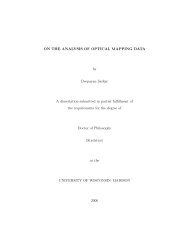Struggles with Survey Weighting and Regression Modeling paper
Struggles with Survey Weighting and Regression Modeling paper
Struggles with Survey Weighting and Regression Modeling paper
You also want an ePaper? Increase the reach of your titles
YUMPU automatically turns print PDFs into web optimized ePapers that Google loves.
SURVEY WEIGHTING AND REGRESSION MODELING 163<br />
Any of these equivalent expressions can be viewed as<br />
the posterior variance of θ given a noninformative prior<br />
distribution on the regression coefficients, <strong>and</strong> ignoring<br />
posterior uncertainty in σ y (Little, 1993).<br />
Dependence of implicit weights on the outcome variable.<br />
Classical survey weights depend only on the n j ’s<br />
<strong>and</strong> the N j ’s, as well as the design matrix X (used, e.g.,<br />
to define the margins used in raking), but do not formally<br />
depend on y. (There is an informal dependence<br />
on y in the sense that there is no urgency to weight<br />
on variables X that do not help predict outcomes y of<br />
interest.) Similarly, the implicit weights (7) obtained<br />
from a classical regression model depend only on n, N<br />
<strong>and</strong> X, not on y.<br />
However, the implicit weights (9) from hierarchical<br />
regression do depend on the data, implicitly, through<br />
the hyperparameters in y <strong>and</strong> β , which are estimated<br />
from the data. Thus, the appropriate weights<br />
could differ for different survey responses.<br />
4. WHERE TO GO NEXT<br />
There are currently two st<strong>and</strong>ard approaches to adjusting<br />
for known differences between sample <strong>and</strong> population<br />
in survey data: weighting <strong>and</strong> regression modeling.<br />
Practical limitations of weighting. The weighting<br />
approach has the advantage of giving simple estimates<br />
for population averages but has several disadvantages.<br />
First, it is not generally clear how to apply weights to<br />
more complicated estim<strong>and</strong>s such as regression coefficients.<br />
There has been some work on weighted regression<br />
for surveys (e.g., DuMouchel <strong>and</strong> Duncan,<br />
1983; Pfeffermann, 1993) but these procedures are not<br />
very flexible, which is one reason why the modeling<br />
approach is more popular for problems such as<br />
small-area estimation (Fay <strong>and</strong> Herriot, 1979). A second<br />
problem <strong>with</strong> weighted estimates is that st<strong>and</strong>ard<br />
errors are more difficult to evaluate (recall Table 3).<br />
Finally, weighting may be “dirty” but it is not always<br />
“quick”: actually constructing the weighting for a survey<br />
is more difficult than you might think. Creating<br />
practical weights requires arbitrary choices about inclusion<br />
of weighting factors <strong>and</strong> interactions, pooling<br />
of weighting cells <strong>and</strong> truncation of weights. (For example,<br />
in the Social Indicators <strong>Survey</strong>, we decided<br />
to weight on some interactions <strong>and</strong> not others in order<br />
to control variability of the weights. While setting<br />
up the weighting procedure, we repeatedly compared<br />
weighted estimates to Census values for various outcomes<br />
that we thought could be “canaries in the coal<br />
mine” if the survey estimate did not fit the population.<br />
These “canary” variables included percentage of<br />
New York City residents who are U.S. citizens, the percent<br />
who own their own home <strong>and</strong> income quintiles.)<br />
The resulting vector of weights is in general a complicated<br />
<strong>and</strong> not-fully-specified function of data <strong>and</strong> prior<br />
knowledge. Subjective choices arise in virtually all statistical<br />
methods, of course, but good advice on creating<br />
weights tends to be much vaguer than for other methods<br />
in the statistical literature (see, e.g., Lohr, 1999).<br />
Practical limitations of modeling. <strong>Regression</strong> modeling<br />
is easy to do—even hierarchical regression is becoming<br />
increasingly easy in Bugs, Stata <strong>and</strong> other software<br />
packages (see, e.g., Centre for Multilevel Modelling,<br />
2005; Gelman <strong>and</strong> Hill, 2007)—but for analysis<br />
of survey data it has the disadvantage that, to combine<br />
<strong>with</strong> population information, the regression must theoretically<br />
condition on all the poststratification cells,<br />
which can lead to very complicated models—more<br />
complicated than we are comfortable <strong>with</strong> in current<br />
statistical practice—even in surveys of moderate size<br />
(see Section 2.2). When a model is too complicated, it<br />
becomes difficult to interpret or use the results, leading<br />
to awkward situations such as in Table 1,wherewe<br />
simply cannot trust the regression coefficients for time<br />
trends in the Social Indicators <strong>Survey</strong>.<br />
It is a delicate point, because sometimes we do have<br />
confidence in regression coefficients, even <strong>with</strong> complicated<br />
hierarchical models <strong>with</strong> many parameters.<br />
For example, as discussed in Gelman <strong>and</strong> Carlin (2002)<br />
<strong>and</strong> Park, Gelman <strong>and</strong> Bafumi (2004), hierarchical regression<br />
combined <strong>with</strong> poststratification performs excellently<br />
at estimating state-level opinions from the national<br />
CBS/New York Times polls. So it is not just the<br />
number of parameters that is important, but rather some<br />
connection between the model <strong>and</strong> the quantities of interest,<br />
which is somehow more difficult to establish in<br />
the models whose results are shown in Table 1.<br />
Putting it together using hierarchical models <strong>and</strong><br />
poststratification. Our ideal procedure should be as<br />
easy to use as hierarchical modeling, <strong>with</strong> population<br />
information included using poststratification as in (1).<br />
The procedure should feature a smooth transition from<br />
classical weighting so that when different estimation<br />
methods give different results, it is possible to underst<strong>and</strong><br />
this difference as a result of interactions in the<br />
model (as discussed by Graubard <strong>and</strong> Korn, 2002).<br />
How do we get there? One place to start is to focus<br />
on examples such as in Table 1 where different methods<br />
give different answers, <strong>and</strong> try to figure out which,
















